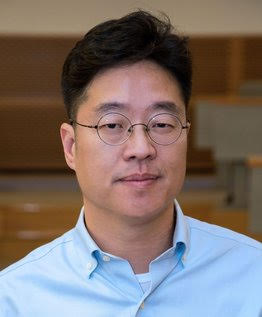It’s a dangerous job, and Dr. Hwang has to do it
David Hwang is a dangerous man.
As head of the Advanced Energy Research and Technology Center’s Laser Solar Photovoltaic Laboratory, he works daily with high-power lasers and a mishmash of toxic chemicals – a hazardous combination requiring a super-safe space and a steady hand.
Fortunately, Dr. Hwang – an associate professor in Stony Brook University’s Department of Mechanical Engineering – has both.
He’s been with the AERTC from the start, opening the Laser Solar Photovoltaic Laboratory in 2011, the year the Advanced Energy Center first opened its doors. His lab rides the cutting edge of laser-assisted advanced manufacturing, incorporating the latest in laser technology to not only cut glass, metals and other materials to exacting specifications, but to alter the molecular state of various substrates – a potential breakthrough of epic proportions in the additive-manufacturing realm.
A prime example of the laboratory’s unique nature rests in its very creation. While Dr. Hwang opened it a decade ago, it took some time to round the Laser Solar Photovoltaic Laboratory into its current shape.
You can’t just throw intense lasers and deadly chemicals into a room and have at it, the associate professor notes. This is “advanced laser interaction with semiconductor gas-type sources,” requiring a vacuum and a safe gas-venting method – particularly vexing, he adds, when setting up shop in an energy-efficient space like the AERTC.
“This building is not just dedicated for energy research, but also at the same time an energy-efficient building,” the researcher says. “I needed certain infrastructure to handle toxic chemical materials.”
Essentially, the Laser Solar Voltaic Laboratory needed to “spit out” the gases without “throwing away” the AERTC’s stored heat, a key to its energy efficiency. And it needed to make these accommodations “at a reasonable cost,” according to Dr. Hwang.
“We spent three to four years figuring out that issue,” he notes.
It was the laboratory’s unique science that ultimately carved out the proper space, turning those dangerous lasers inward to “cut out some of the duct,” Dr. Hwang says, and create “a limited section for toxic chemicals.”
The Laser Solar Photovoltaic Laboratory wasn’t the only space to benefit from the work – other projects working with toxic substances were also able to cut-and-paste their way around the AERTC’s ventilation and air-conditioning systems, without taxing energy efficiency or creating biohazards.
And Dr. Hwang’s laboratory didn’t do it alone. He cites a winning combination of AERTC minds working the infrastructure effort – a terrific example of the Advanced Energy Center’s collaborative nature.
Now firing on all cylinders, the Laser Solar Photovoltaic Laboratory continues that collaboration, working closely with Brookhaven National Laboratory’s Center for Functional Nanomaterials and the National Research Foundation of Korea, among other major-league institutions.
It’s also formed several industry partnerships. Its leader references “laser-assisted chemical vapor deposition for the encapsulation of organic energy devices” for one solar-cell industry client, and a multiyear effort for an undisclosed “big semiconductor company” – among the laboratory’s biggest projects to date – involving a “laser-coupled sputter deposition process.”
Meanwhile, a new Center for Laser Manufacturing lurks in the wings, waiting for Stony Brook’s $60 million Innovation and Discovery Center to complete construction and welcome tenants.
Along with Alexander Orlov – a professor in SBU’s Materials Science & Chemical Engineering Department and founder of nanostructure-focused energy-storage innovator Fluxion Technology, a longtime AERTC resident – Dr. Hwang secured state funding for the new Center for Laser Manufacturing, which will be stocked with generous equipment donations from Massachusetts-based IPG Photonics, a manufacturer of high-performance fiber lasers and amplifiers for diverse industrial applications.
But even with $1.5 million in state grants and copious equipment donations from IPG Photonics and other corporate partners, when the laser center will open remains unclear.
The space that will be the Innovation and Discovery Center has served various front-line roles throughout the COVID-19 pandemic. When it’s finally cleared for its original, designed use, Dr. Hwang notes, it will take six months to a year to get up to speed.
Whenever it opens, it will be another example of the collaboration that makes the Advanced Energy Center – and all of SBU’s disparate scientific pursuits – so successful, according to Dr. Hwang
“The uniqueness of my research is to couple lasers with toxic chemicals, and there’s no place to safely do that,” he says. “And I’m adding value by … machining with the laser, but the base materials and systems that require this expertise – those are all provided by my partners.
“I can cut the materials,” Dr. Hwang adds. “But I need my partners, including partners in Korea and the Center for Functional Nanomaterials and here in the AERTC.”
